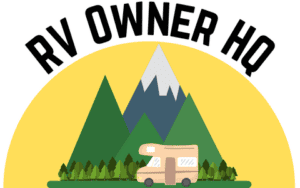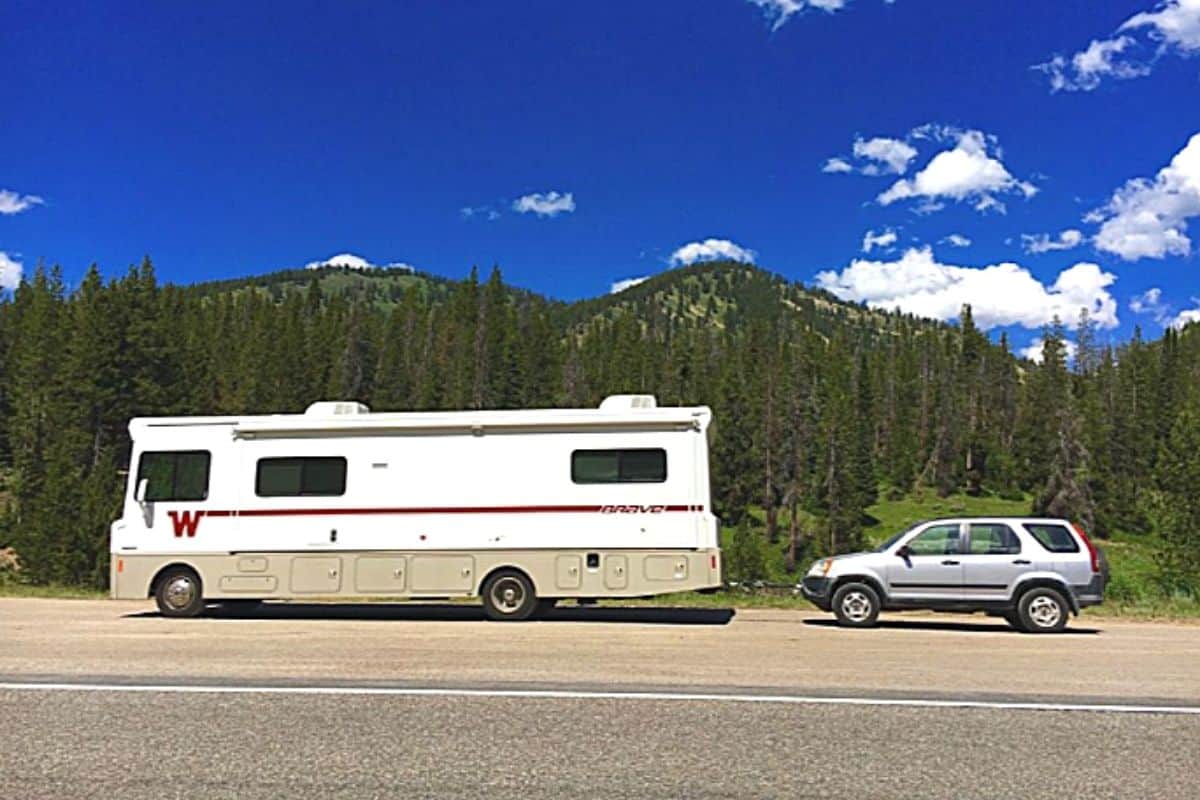Class A RVs are the largest type of motorhomes available, with lengths often ranging from 30 to 40 feet.
They’re also the most powerful, with the highest towing capacities due to their larger engines, robust transmissions, stout chassis, and heavy-duty suspensions.
But can Class A RVs tow a car?
The short answer is yes. On average, Class A RVs have a towing capacity that ranges from 5,000 to 10,000 pounds, which is more than sufficient to tow most cars.
If you’re new to RVing or considering towing a car with your motorhome though, there are several important considerations to keep in mind.
Which is what the rest of this blog post is all about.
So, before you tow a car with a Class A RV, keep reading.
How Much Can a Class A RV Tow?
Just like other RV classes, there are a wide variety of Class A motorhomes available today.
Ranging from small, entry-level front-engine gasoline options to large, luxury rear-engine diesel ones.
Because of this, towing capacities for Class A RVs can vary significantly: from as low as 5,000 pounds to as much as 20,000 pounds.
However, on average, the majority of Class A RVs typically have a towing capacity that ranges from 5,000 to 10,000 pounds.
For a more detailed answer on the towing capacity of a Class A RV and the factors that affect it, check out our blog post “How Much Can a Class A Motorhome Tow? (15 Examples)“.
What are the Different Ways to Tow a Car Behind a Motorhome?
If you’re new to RVing, you might be surprised to learn that there are actually three different ways to tow a car behind a motorhome.
These methods affect not only the towing setup but also the type of car you can tow.
To better understand these different towing techniques, let’s delve into each one individually.
As each method has its own advantages, requirements, and potential challenges.
Flat Towing (Four Wheels Down)
This is one of the most popular methods for towing vehicles behind motorhomes.
It allows all four wheels of the towed vehicle to be on the ground. This is convenient because you don’t need additional expensive equipment like a trailer or a dolly.
However, not all vehicles are designed to be flat towed. Before using this method, it’s important to consult the vehicle’s owner’s manual or the manufacturer to ensure it can be safely towed this way.
Dolly Towing (Two Wheels Down)
For this method, the front two wheels of the towed vehicle are placed on a dolly, while the rear wheels stay on the ground.
This is a good option for front-wheel drive cars that cannot be flat towed.
Don’t forget though that the dolly adds extra weight to the towing setup, and should be factored into the motorhome’s towing capacity.
In addition, it’s also important to ensure the dolly’s brakes are synchronized with the motorhome for safety.
Trailer Towing
In this method, the entire towed vehicle is loaded onto a trailer, lifting all four wheels off the ground.
This method is the most versatile, accommodating almost any car, motorcycle, or any other type of vehicle, such as golf carts or UTVs.
However, the combined weight of the vehicle and trailer can be significant, so it’s crucial to ensure the motorhome can handle the load.
What Factors Should Be Considered Before Towing a Car With an RV?
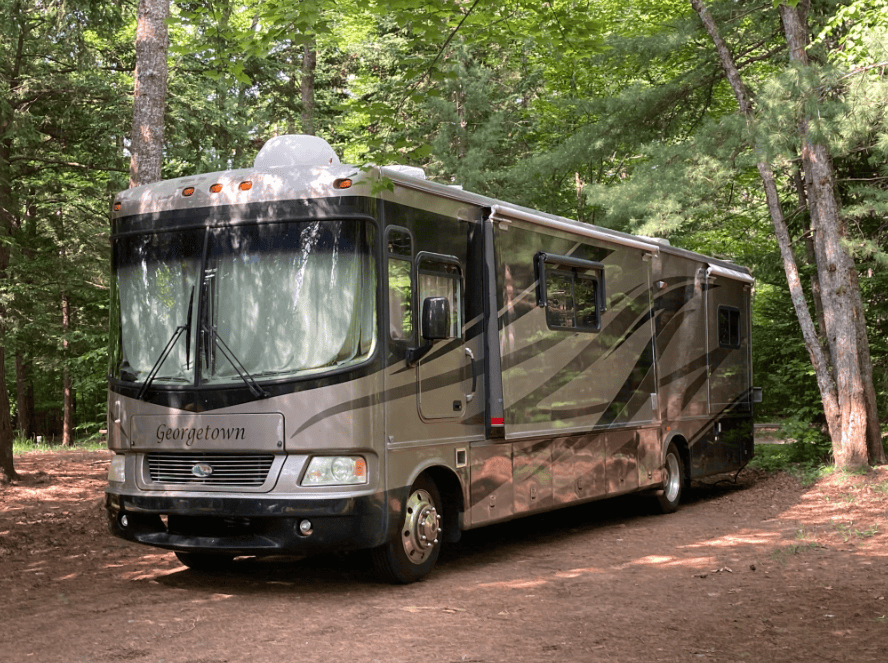
Before towing a car behind a motorhome there are several factors you need to consider, which we’ve outlined below.
To ensure safe towing, legal compliance, and the protection of both your RV and the towed vehicle.
RV Towing Capacity
One of the most important factors to consider when towing a car with a Class A motorhome is the towing capacity of the RV itself.
However, there’s more to this than just figuring out what the RV’s maximum tow capacity is.
Because even if a Class A motorhome has a stated 5,000-pound max towing capacity that doesn’t mean you can always safely tow a 5,000-pound vehicle with the RV.
The reason is that you also need to factor in the cargo and passenger weight inside the RV, as well as the gross combined weight of the RV and the tow vehicle.
Since both of these weights can influence the towing capacity of the RV.
This is why every RV will also have a gross vehicle weight rating and a gross combined weight rating.
- Gross Vehicle Weight Rating (GVWR) – The maximum weight the RV can handle including passengers, cargo, and holding tanks.
- Gross Combined Weight Rating (GCWR) – The maximum allowable combined weight of the RV and any towed vehicles or trailers.
So to calculate your actual available towing capacity, you need to subtract the loaded weight of the RV from its gross combined weight rating.
As this difference in weight lets you know how much weight the RV can safely tow.
Also, don’t forget, when towing with a motorhome, general best tow practices still apply.
Because of this, you should be adhering to the 80 Rule for towing, which states that you should never tow more than 80 percent of the vehicle’s max tow capacity.
Towed Vehicle or “Toad”
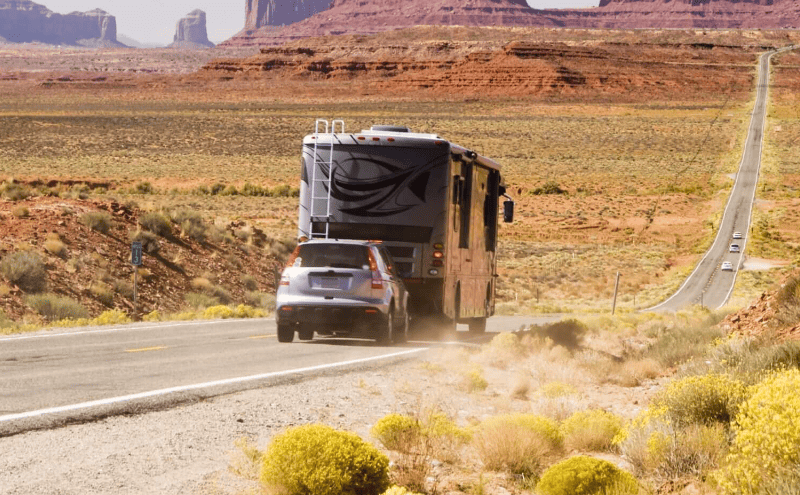
When deciding on a vehicle to tow behind your motorhome, there are many factors to consider.
We’ve highlighted the most important ones below.
Most Important Factors to Consider When Choosing a Vehicle to Tow Behind a Motorhome:
- Towability: Not all vehicles are suitable for flat towing and even if they are, certain production years or trim levels may not be. Always consult the manufacturer to determine if the vehicle can be flat towed.
- Vehicle Weight: Vehicle weight should never exceed the RV’s max tow capacity or its gross combined weight rating. (More on this later.)
- Transmission Type: Manual transmissions are usually more suitable for flat towing than automatic ones. That said, some automatic vehicles can be flat towed if they have features like a transmission disconnect and steering lockout override.
- Front-Wheel vs. Rear-Wheel Drive: Front-wheel-drive cars are typically easier to tow using a dolly, as only the front wheels need to be off the ground. Rear-wheel-drive vehicles often require special considerations or equipment.
- Aftermarket Modifications: Some vehicles might need aftermarket modifications, like lube pumps or transmission disconnects, for towing. This can affect a vehicle’s warranty. (More on this later.)
- Size and Dimensions: Generally, lighter and more compact vehicles are easier to tow and maneuver. Pay attention to vehicle height and ground clearance as well, as low-slung cars are at a higher risk of sustaining damage while being towed.
- Purpose and Use: Select a vehicle based on its main intended purpose. For instance, do you need a car for everyday use at your destination, or is something more suited for off-roading more appropriate?
- Cost of Tow Equipment: Some vehicles demand more expensive towing setups, such as a tow dolly or a trailer. Research these costs in advance to avoid unexpected expenses.
Selecting the right vehicle to tow behind an RV involves both practical considerations and personal preferences.
So make sure to do plenty of research and think about what you need from the towed vehicle or “toad” as it’s sometimes called.
Weight of the Towed Vehicle
When towing with a Class A RV, it’s crucial to have a clear understanding of the vehicle’s weight you intend to tow.
As even vehicles in the same class, like compact SUVs can have significantly different curb weights.
In fact, even a specific vehicle can have different curb weights, based on its production year, trim level, and equipment package.
So you never want to ballpark the weight of a vehicle being towed.
Instead, you always want to know the specific curb weight of that specific vehicle.
In addition, it’s also important to account for not only the car’s base weight but also any additional cargo loaded into the vehicle.
As such cargo can often add several hundred pounds to the vehicle’s overall weight.
Understanding these weights is important because towing a vehicle that exceeds the RV’s capacity can result in serious issues.
Including but not limited to strain on the RV’s engine, decreased brake efficiency, and potential instability in the RV towing setup, particularly during high-speed scenarios or sudden turns.
So to be extra safe when towing a car with a Class A RV, it’s a good idea to weigh the vehicle loaded at a certified scale, especially if it’s undergone any modifications.
As this will ensure that the vehicle’s weight is within the RV’s limits.
Towing Equipment
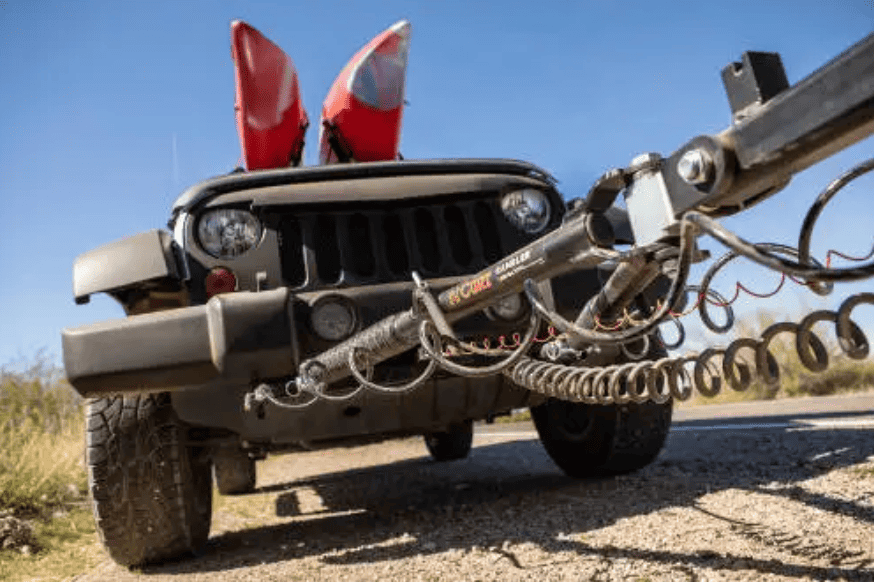
Whether you opt for flat towing, dolly towing, or trailer towing behind your Class A RV, the importance of the right equipment cannot be overstated.
That’s because each method comes with its own unique set of requirements and challenges.
For example, flat towing (also known as dinghy towing) requires tow bars and a base plate, whereas dolly towing requires specialized straps and, naturally, a dolly.
On the other hand, trailer towing requires a trailer hitch ball and receiver as well as a large enough trailer to handle a full-size vehicle.
Regardless of your preferred towing method though, you should always prioritize high-quality robust towing equipment.
Even if it means paying a premium.
As investing in top-notch equipment ensures peace of mind, as cheap towing products can compromise the safety of the rig.
For example, a weak connection point or a faulty braking system can lead to disastrous results, from damage to the RV and towed vehicle to major road accidents.
Some of our favorite brands for towing equipment include Curt, Reese, Roadmaster, Blue Ox, Bulletproof, and Demco.
Having quality towing equipment is only half the battle though, as you also need to properly maintain it as well.
By regularly inspecting and performing any needed maintenance.
As this will ensure years of safe and trouble-free use.
Safety Precautions Around Towing
Ensuring safety is paramount when towing a car with a Class A RV, and it extends beyond just having the right equipment.
Safety demands a comprehensive approach throughout the entire towing process, beginning with a thorough pre-towing inspection.
Before setting out on any journey, take the time to thoroughly inspect the towing setup.
This includes checking connection points, chains, cables, brakes, lights, and turn signals, and assessing the overall condition of the towing equipment.
In addition, it’s always a good idea to spend those extra few minutes confirming that everything is securely fastened and properly strapped down.
Once on the road, remember that driving dynamics can change significantly when towing with a Class A RV.
As the additional length and weight can affect maneuverability, especially in scenarios like turning, reversing, or braking.
So it’s always a good idea when towing with an RV to give yourself a wider berth when turning and to pay special attention when navigating tight spaces.
Plus, keep in mind that your stopping distance will likely increase while towing, due to the added weight.
So always maintain a greater gap between you and the vehicle in front of you while towing.
Legal & Regulatory Considerations
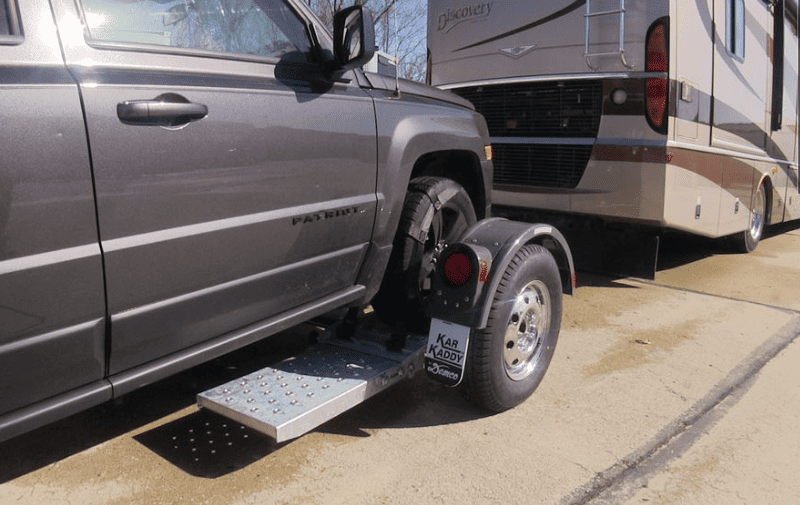
Navigating RV towing isn’t just about logistics and safety—it’s also about being well-versed in the legal and regulatory requirements of towing.
For example, the maximum allowable towing weights, as well as width and length limits, can vary, which will determine the size and type of vehicle you can tow.
Additionally, some states may impose different speed limits for vehicles towing loads, or they might mandate the use of auxiliary mirrors to improve visibility.
Requirements for lighting, reflectors, and signage are also important to know.
Often, brake lights and turn signals on the towed car must be synchronized with the RV, to ensure clear communication with other drivers.
Also, safety chains and or cables are almost always required.
Then there’s the matter of auxiliary braking systems.
In certain states, the law requires towed vehicles that exceed a specific weight to have an independent braking system.
Because of all these regulations, it’s essential to familiarize yourself with the various towing regulations and laws.
For not only your state but any state you plan to tow in, as they do vary somewhat.
Doing so can save you future hassles and possibly even a ticket down the road.
After all, ignorance is never a defense in the eyes of the law.
RV Towing & Insurance
When towing a car with a Class A motorhome, insurance is pivotal for both financial protection and peace of mind.
You might assume that your existing RV or auto insurance automatically extends to a towed vehicle, but this isn’t always the case.
So it’s important to review your policy details and or consult with your insurance provider.
This will ensure that your coverage protects both the RV and the towed car, as well as covers any liability should an accident involve another party.
It’s also worth mentioning that the type of towing you plan on doing can affect the kind of coverage you need.
For example, a car on a trailer might be considered cargo, which would potentially require different coverage, than a car being flat towed.
Securing comprehensive and suitable insurance coverage isn’t just about compliance.
It’s an investment to shield against unexpected costs and potential legal issues.
So always make it a point to periodically review and update your insurance to reflect your current towing practices and needs.
RV Towing & Vehicle Warranties
Towing a vehicle, particularly using methods like flat towing, can impact the car’s warranty.
Many auto manufacturers incorporate specific clauses in their warranties concerning towing, even if the vehicle is technically suitable for flat towing.
For example, some warranties stipulate that flat towing without adhering to certain guidelines can void the warranty, especially if damage results.
This is particularly relevant for vehicles with automatic transmissions, which often cannot be flat towed without specific features or modifications.
So before towing any vehicle, warranty or not, you should always consult the owner’s manual or the manufacturer’s official guidance on towing.
Because even if a vehicle is designated as “towable” or “dinghy towable” by the manufacturer, there are usually precise instructions on proper towing procedures.
Also, before you make any modifications to make a vehicle towable, you should always consult with the vehicle’s dealer or manufacturer first.
As modifying the vehicle can affect its warranty status.
As the vehicle’s manufacturer might view the modifications as alterations to the vehicle’s original design, which could void the warranty.
Popular Vehicles that are Class A RV Towable (Lightest to Heaviest)
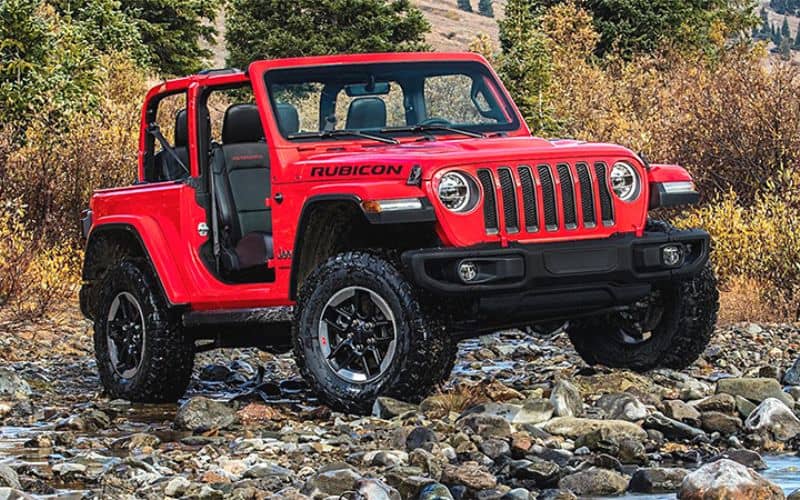
Choosing the right vehicle to tow behind a Class A RV typically depends on two key factors including towability and curb weight.
So we’ve compiled this list of the most popular vehicle choices among RVers.
Ranking them from lightest to heaviest based on their current curb weight.
(Remember though, popularity doesn’t guarantee universal towability, especially flat towing. As often only certain vehicle production years or trim levels can be flat towed.)
- Chevrolet Equinox: 3,274 – 3,512 lbs
- Subaru Crosstrek: 3,276 – 3,369 lbs
- Honda CR-V: 3,337 – 3,649 lbs
- GMC Terrain: 3,419 – 3,695 lbs
- Jeep Cherokee: 3,875 to 4,260 lbs
- Jeep Wrangler: 3,948 – 5,103 lbs
- Ford F-150: 4,070 – 5,757 lbs
- Ford Ranger: 4,203 – 5,325 lbs
- Jeep Grand Cherokee: 4,238 – 4,784 lbs
- Chevrolet Colorado: 4,270 – 4,940 lbs
- Dodge Durango: 4,750 – 5,710 lbs
- Ram 1500: 4,779 – 6,440 lbs
- Ford Expedition: 5,443 – 5,623 lbs
Additional Resources:
- Best Cars To Tow Behind RVs
- The Best Cars to Tow Behind an RV
- Vehicles That Can Be Flat Towed
- What Vehicles Can Be Flat Towed?
Recent Posts
47 RV Storage Ideas to Maximize Your Space for Compact Living
Camping and living in an RV is an incredible adventure, but it comes with its fair share of challenges, particularly around storage, due to the lack of space. Because of this, it's a must to make...
Are you looking to give your RV a cozy, rustic makeover? If so, farmhouse RV decor is the perfect style to transform your camper into a warm and inviting home on wheels. In this blog post, I'll...
